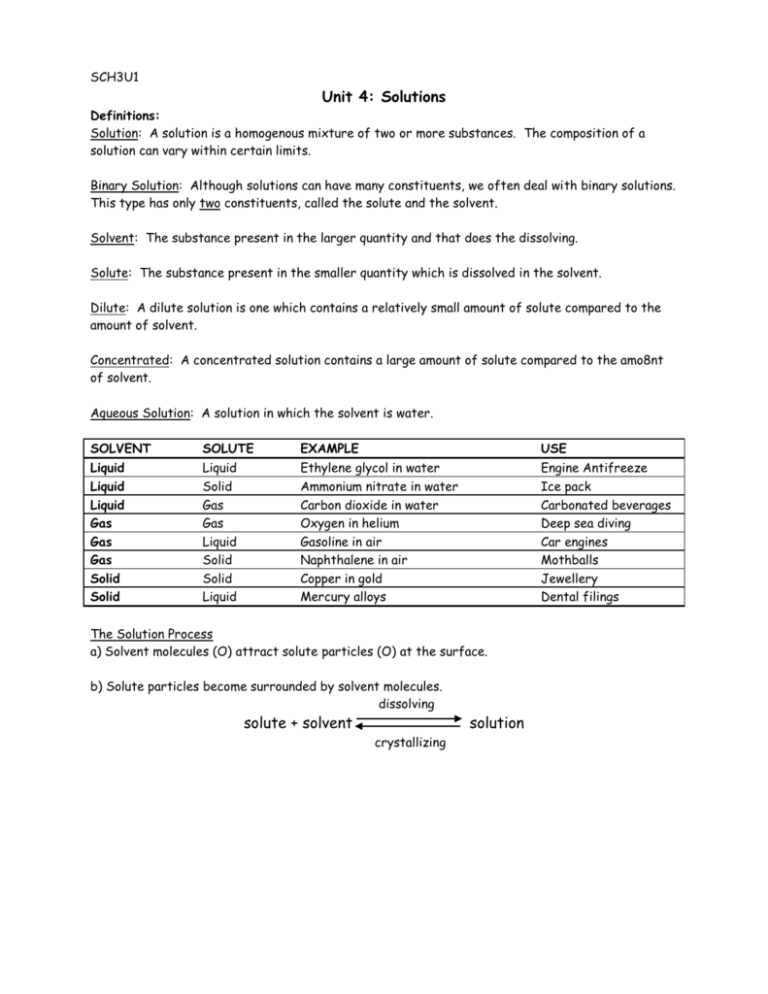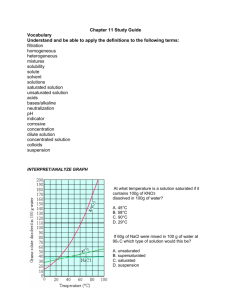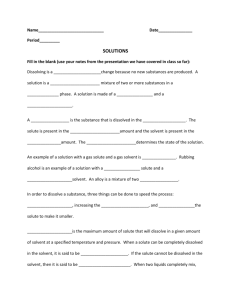SCH 3U Solution Terms, Dissociation, Solubility curves note
advertisement

SCH3U1 Unit 4: Solutions Definitions: Solution: A solution is a homogenous mixture of two or more substances. The composition of a solution can vary within certain limits. Binary Solution: Although solutions can have many constituents, we often deal with binary solutions. This type has only two constituents, called the solute and the solvent. Solvent: The substance present in the larger quantity and that does the dissolving. Solute: The substance present in the smaller quantity which is dissolved in the solvent. Dilute: A dilute solution is one which contains a relatively small amount of solute compared to the amount of solvent. Concentrated: A concentrated solution contains a large amount of solute compared to the amo8nt of solvent. Aqueous Solution: A solution in which the solvent is water. SOLVENT SOLUTE EXAMPLE USE Liquid Liquid Liquid Gas Gas Gas Solid Solid Liquid Solid Gas Gas Liquid Solid Solid Liquid Ethylene glycol in water Ammonium nitrate in water Carbon dioxide in water Oxygen in helium Gasoline in air Naphthalene in air Copper in gold Mercury alloys Engine Antifreeze Ice pack Carbonated beverages Deep sea diving Car engines Mothballs Jewellery Dental filings The Solution Process a) Solvent molecules (O) attract solute particles (O) at the surface. b) Solute particles become surrounded by solvent molecules. dissolving solute + solvent crystallizing solution Rate of Dissolving: A given solute will dissolve faster in a given solvent: a) if the solute is more finely divided, presenting more surface area. b) if the temperature of the solvent is increased. c) if the mixture is stirred, continually bringing fresh solvent in contact with the undissolved solute. Dissociation: Dissociation refers to the dissolving of ionic compounds in which the ions separate from each other and the crystal lattice. The resulting ions are called hydrated or aqueous ions. For example, the polar solvent water dissolves the ionic compound NaCl: Dissociation Equations: NaCl (s) Na+ (aq) + Cl- (aq) Na2SO4 (s) 2 Na+ (aq) + SO42- (aq) (NH4)3PO4 (s) NaOH (s) 3NH4 (aq) + PO43- (aq) Na+ (aq) + OH- (aq) Saturated: A saturated solution is one which contains the maximum amount of solute that can be dissolved in a given amount of solvent at a particulate temperature. Unsaturated: An unsaturated solution is one which contains less than the maximum amount of solute that can be dissolved in a given amount of solvent at a particulate temperature. Supersaturated: Sometimes, a saturated solution may be heated to dissolve extra solid and then carefully cooled to the original temperature without the reappearance of the extra solid. This solution is not stable because the addition of a small crystal or agitation of the solution can cause crystallization. A solution with more solute than a saturated solution is said to be supersaturated. To test for supersaturation, simply place a small crystal in a solution: a) If the crystal gets smaller, the solution is unsaturated. b) If the crystal does not change, the solution is saturated. c) If the crystal grows, the solution is supersaturated. Solubility Curves Concentration: The amount of solute dissolved in a certain volume of solvent. Solubility: This refers to the maximum amount of solute that can be dissolved in a certain amount of solvent at a particular temperature. Therefore it is the concentration of a saturated solution at a particular temperature. The Effect of Temperature of Solubility Gases: In the case of gases dissolved in liquids, rising temperatures cause the gas molecules to leave the liquid. Thus the solubility of gases in a liquid decreases as the temperature of the solvent increases. Liquids: Since energy is required for solids to dissolve in liquids, solids are more soluble in warmer liquids. The heat energy allows solute particles to break away from the crystal. This effect is seen in solubility curves. SOLUBILITY PROBLEM SET 1) Draw a solubility curve for potassium chlorate using the following data: Temp (oC) 0 10 20 30 40 50 60 70 Solubility 3.3 5.0 7.4 10.5 14.0 19.3 24.5 (g/100g H2O) 80 38.5 90 2) What is the solubility of KClO3 at: a) 70oC? b)27oC? 3) At what temperature is the solubility: a) 44 g/100 g H2O? b) 6 g/100 g H2O? 4) Identify each of the following as being either saturated, unsaturated or supersaturated: a) A solution made by dissolving 20 g KClO3 in 100 g H2O at 55oC. b) A solution made by dissolving 10.5 g KClO3 in 100 g H2O at 30oC, c) A solution made by dissolving 12 g KClO3 in 100 g H2O at 31oC. 5) A solution is made by dissolving 20 g KClO3 in 100 g H2O at 60oC. State three ways to make the solution saturated. 6) A saturated solution of KClO3 is cooled from 95oC to 50oC. How much KClO3 will settle out of solution? 7) A solution is made by dissolving 32 g KClO3 in 100 g of H2O at 80oC. The solution is cooled to 10oC. Describe what you would observe and at what temperature this first occurs at. What mass of crystals will settle out of solution? 100 57.0






